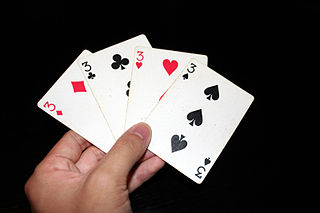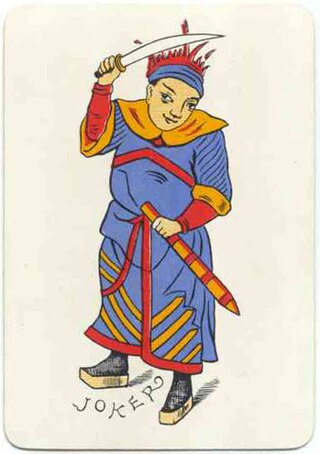
Mahjong is a tile-based game that was developed in the 19th century in China and has spread throughout the world since the early 20th century. It is played by four players. The game and its regional variants are widely played throughout East and Southeast Asia and have also become popular in Western countries. The game has also been adapted into a widespread online entertainment. Similar to the Western card game rummy, mahjong is a game of skill, strategy, and luck. To distinguish it from mahjong solitaire, it is sometimes referred to as mahjong rummy.

Pinochle, also called pinocle or penuchle, is a trick-taking ace–ten card game, typically for two to four players and played with a 48-card deck. It is derived from the card game bezique; players score points by trick-taking and also by forming combinations of characters into melds. It is thus considered part of a "trick-and-meld" category which also includes the game belote. Each hand is played in three phases: bidding, melds, and tricks. The standard game today is called "partnership auction pinochle".

Gin rummy, or simply gin, is a two-player card game variant of rummy. It has enjoyed widespread popularity as both a social and a gambling game, especially during the mid twentieth century, and remains today one of the most widely played two-player card games.

500 rum, also called pinochle rummy, Michigan rummy, Persian rummy, rummy 500 or 500 rummy, is a popular variant of rummy. The game of canasta and several other games are believed to have developed from this popular form of rummy. The distinctive feature of 500 rum is that each player scores the value of the sets or cards they meld. It may be played by 2 to 8 players, but it is best for 3 to 5.
Japanese Mahjong scoring rules are used for Japanese Mahjong, a game for four players common in Japan. The rules were organized in the Taishō to Shōwa period as the game became popular.

Rummy is a group of games related by the feature of matching cards of the same rank or sequence and same suit. The basic goal in any form of rummy is to build melds which can be either sets or runs and either be first to go out or to amass more points than the opposition.

Rummikub is a tile-based game for 2 to 4 players, combining elements of the card game rummy and mahjong. There are 106 tiles in the game, including 104 numbered tiles and two jokers. Players have 14 tiles initially and take turns putting down tiles from their racks into sets of at least three, drawing a tile if they cannot play. Players have a two-minute time limit for their turn. In the Sabra version, the first player to use all their tiles scores a positive score based on the total of the other players' hands, while the losers get negative scores. Variations of the game contain four jokers. An important feature of the game is that players can move and reuse the tiles that have already been placed on the table. The game can also be played with 2 decks of playing cards with suit being different colors and number as follows : Ace = 1, Number 2-10 = their number, Jack = 11, Queen = 12, King = 13 and with Jokers.
Hong Kong mahjong scoring rules are the rules used for scoring in mahjong, specifically the rules common in Hong Kong and some areas in Guangdong.
Tonk, or tunk, is a matching card game, which combines features of knock rummy and conquian. Tonk is a relatively fast-paced game that can be played by 2–4 players. It can be played for just points or for money wagered.

Okey is a tile-based game, popular in Turkey, of the rummy family. The aim of the game is to score points against the opposing players by collecting certain groups of tiles. It is usually played with four players, but can also be played with only two or three players.

Four color cards is a game of the rummy family of card games, with a relatively long history in southern China. In Vietnam the equivalent game is known as tứ sắc.
In Japanese mahjong, yaku is a condition that determines the value of the player's hand. It is essential to know the yaku for game strategy, since a player must have a minimum of one yaku in their hand in order to legally win a hand. Each yaku has a specific han value. Yaku conditions may be combined to produce hands of greater value. The game also features dora, that allow a hand to add han value, but they do not count as yaku. Altogether, a hand's points value increases exponentially with every han.

Khanhoo or kanhu is a non-partnership Chinese card game of the draw-and-discard structure. It was first recorded during the late Ming dynasty as a multi-trick taking game, a type of game that may be as old as Tien gow, revised in its rules and published in an authorized edition by Emperor Gaozong of Song in 1130 AD for the information of his subjects. Meaning "watch the pot", it is very possibly the ancestor of all rummy games.
Indian Cherokee Rummy is a card game in India with little variation from original rummy. It may be considered a cross between Rummy 500 and gin rummy. Indian Rummy is a variant of the rummy game popular in India that involves making valid sets out of 13 cards that are distributed among every player on the table. Each player is dealt 13 cards initially; if the number of players is 2, then a 52 cards deck is chosen for the game and if there are 6 players, two decks of 52 cards each is combined for the game. Each player has to draw and discard cards by turns till one player melds their cards with valid sets that meet the Rummy validation rules. It could be that Indian Rummy evolved from a version of Rummy in South Asia, Celebes Rummy, also called Rhuk.
Japanese mahjong, also known as riichi mahjong, is a variation of mahjong. While the basic rules to the game are retained, the variation features a unique set of rules such as riichi and the use of dora. The variant is one of a few styles where discarded tiles are ordered rather than placed in a disorganized pile. This is primarily due to the furiten rule, which takes player discards into account. The variant has grown in popularity due to anime, manga, and online platforms.

Schnapsen, Schnapser or Schnapsa is a trick-taking card game of the bézique (ace–ten) family that is very popular in Bavaria and in the territories of the former Austro-Hungarian Empire and has become the national card game of Austria and Hungary. Schnapsen is both of the point-trick and trick-and-draw subtypes.

Three-player mahjong is a variation of mahjong for three players rather than the more common four-player variations. It is not a mere adaption of four-player mahjong to suit only three players but has its own rules and idiosyncrasies that place it apart from the more standard variations. The equipment used and the basic mechanisms are much like four-player variations though some tiles are removed, certain plays are prohibited and the scoring system is simplified. The game is embraced in some Asian countries while ignored or snubbed in others.

American mahjong, also spelled mah jongg, is a variant of the Chinese game mahjong. American mahjong utilizes racks to hold each player's tiles, jokers, and "Hands and Rules" score cards. It has several distinct gameplay mechanics such as "The Charleston", which is a set of required passes, and optional passing of the tiles.

Binokel is a card game for two to eight players that originated in Switzerland as Binocle, but spread to the German state of Württemberg, where it is typically played with a Württemberg pattern pack. It is still popular in Württemberg, where it is usually played in groups of three or four as a family game rather than in the pubs. In three-hand games, each player competes for himself, while in four-hand games, known as Cross Binokel (Kreuzbinokel), two teams are formed with partners sitting opposite one another. The game was introduced to America by German immigrants in the first half of the 20th century, where it developed into the similar game of pinochle. Binocle was still played in Switzerland in 1994. In south Germany, the game is sometimes called by its Swabian name, Benoggl.
Digging Flowers, also known as Dachen Mahjong is a tile-based game similar to mahjong and rummy in which four players compete to form their own winning hand of 21 tiles using melds of two- and three-tile sets. Like mahjong, players build their hands by both drawing from a shuffled wall and acquiring discards from other players.











